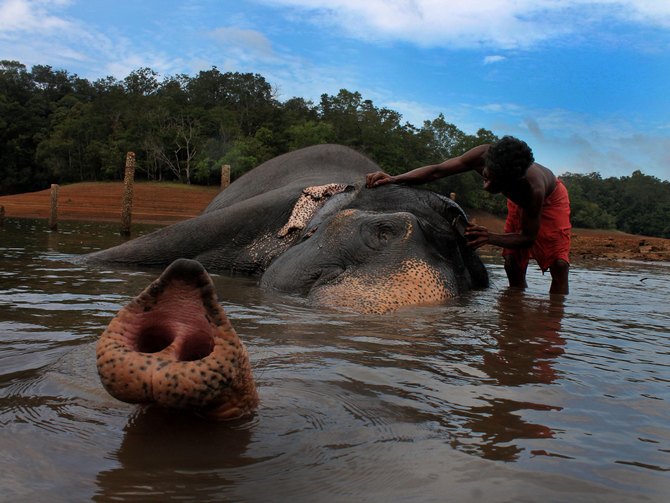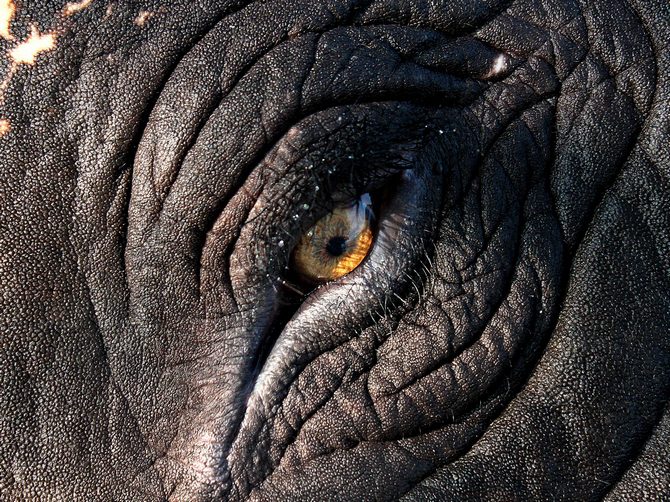
Anand Shinde has been photographing elephants for the last two years in Kerala trying hard to dispel the notion of elephants being mere crop destroyers.
This is an account of his unusual love for the beast!
It is pouring in Thiruvananthapuram and Anand Shinde has been holed up in his office. Shinde works as a photographer for a national newspaper.
He has a 6 pm assignment but if the rain doesn't stop it'll be cancelled and he will most likely have to wait it out indoors till the sky clears out.
Shinde is used to the unpredictability.
About two years ago, when he was transferred from the newspaper's Mumbai offices to Thiruvananthapuram, he found himself in an alien city that spoke a language he didn't speak or understand.
Work, as always, consumed him but there was more he wanted to do... shoot a project on the ancient martial art form of Kalaripayattu or the colourful Kathakali dance form.
But a phone call from Bandeep Singh, the photo editor of Fortune India magazine, would change his life forever.
'Agar aap Kerala mein ho toh haathi dikha do' ('If you're in Kerala show me some elephants', he said.)
Those words -- Shinde quotes them verbatim -- got him started.
"I was apprehensive initially. But Bandeep asked me to give it a shot anyway," Shinde says.
By the time he'd moved cities it was mid-April, which meant he was just in time for Thrissur Pooram, one of the most popular temple festivals in Kerala that sees a large group of elephants from various temples congregate at Thrissur.
"I shot some pictures and sent them to Bandeep. He asked me to shoot some more and suggested I visit some of the elephant centres in Kerala."
And that was the beginning of how elephants changed Anand Shinde's life.
Shinde's wife, Shriya Patil, also a photographer, was the first to witness those changes in her husband.
"Earlier, expenses, the home loan, the EMIs used to get to him. He was materialistic.
"Being with elephants made him realise that there was more to life than money; it made him calmer."
***
Soon after Thrissur Pooram, Shinde made his way to elephant rehabilitation centres in various parts of the state, concentrating primarily on Konni, Kottoor and Kodanad that were the closest to Thiruvananthapuram.
"The media coverage on elephants has largely been negative and largely restricted to the destructive nature of the animal.
"But what I saw of elephants in the centres was drastically different.
"They came across as being friendly creatures. And I was keen on knowing how one could change this popular perception.
"When I showed a colleague who covers the wildlife beat for the paper pictures from Kottoor and discussed the idea with him, he helped me get in touch with V Gopinathan the (then) Chief Wildlife Warden."
Gopinath (who has since been promoted and is now the head of Kerala's Forest Force) seemed enthused with the idea and granted him further access to the centres.
It was in the Kodanad rehabilitation centre that Shinde met Krishna, a baby elephant with whom he would forge a bond.
Krishna had been separated from his herd and much like Shinde found himself in unfamiliar surroundings quite so suddenly.
"I can never put a finger on it but there was something that drew me to him," Shinde says.
"I would sit before his cage for hours much to the amusement of the mahouts and the workers.
At first he would simply observe Krishna.
According to conservationist Daphne Sheldrick, the moment you take the baby elephant out of its natural surroundings, you reduce its chances of survival by 50 per cent.
"Often the forest department is blamed for this, but it's not really their fault," Shinde says.
"Mostly, they withdraw into a shell, soon they get depressed, sometimes they get injured and then they give up.
"The elephant is a very emotional creature. So the first big task for any rehabilitation centre is to get the baby elephant to play.
"If you see it playing, that's the first sign that it is adapting itself well to the new surroundings. Half your battle is won right there."
Krishna wasn't showing those signs. To make matters worse, he had also managed to fracture his leg.
Please click NEXT to continue reading...

Sitting across the cage from Krishna, Shinde realised that besides the trumpeting, elephants also make a much softer rumbling sound to communicate with each other.
"And that was when I began to imitate Krishna's rumbling.
"I didn't know what he was trying to say; I just blindly imitated him," he recollects.
Before long, the two seemed to understand each other and then Anand Shinde began, for the first time, speaking with an elephant... in Marathi, his mother tongue. And Krishna seemed to understand exactly what was being said!
Back home, his wife seemed rather amused by what he was doing but continued to encourage him anyway, sending him reading material via email or just lending him a patient ear.
During one particular telephone conversation when he told her how Krishna was communicating with him, she asked him if he had any evidence to prove that he was in fact 'talking'.
"That was when I began shooting videos to document behaviour patterns of elephants.
"I showed some of these videos to Gopinath and suggested that if we train mahouts better, their interaction with elephants can bring down the number of elephant deaths.
"In captivity, the mahout is everything to the elephant and that makes it all the more important to change the way the mahouts communicate with the animals," he says.
So in November last year, he put forth the idea before a delegation of top forest officers in Kerala who were impressed with his suggestions and flew in an expert to help train their staff.
Among his other suggestions is the redesigning of elephant enclosures at the rehabilitation centres, which make them safer and better for the little ones.
Gopinath who heads Kerala's Forest Force said that Shinde's findings -- the photographs and videos -- have reminded them that the bond between the elephant and the mahout is a tender but an important one.
It is always good to be reminded about these things, he said, adding that he's seen the animals, especially the calves, bonding with the humans better over the last couple of years.
***
Several of the videos stored away in Shinde's laptop -- none of them are in public circulation since they've been used to make presentations for the forest department -- are those of Krishna, playing with Shinde, warming up to him and pleading him not to go each time he would get up to leave.
There was one particular moment however that wasn't captured on camera though -- the time that the elephant lovingly placed his trunk on the head of his new human friend.
"I've never felt so loved," Shinde says, "I broke down."
And then there was another one when during a thunderstorm Krishna wouldn't let him leave.
But the most heartening video, Shinde says, is of their final meeting.
"My mother was critical and I was to leave for Mumbai. He simply refused to let me go. It was a task trying to leave."
In an almost cinematic twist in the plot, as Shinde's mother began recovering miraculously in Mumbai, unknown to him Krishna's health began to deteriorate in Kodanad before finally he breathed his last.
While on the one hand he was relieved about his mother's health, Shinde was also heartbroken.
But by now he had also learnt that he possessed a gift that few have -- the ability to communicate with elephants.
Please click NEXT to continue reading...

In June last year, Anand Shinde received a call from a friend.
Veterinarians, experts and animal rights activists were struggling with Bijlee.
The 58-year-old elephant who had collapsed under her own weight on June 11 in suburban Mumbai and was suffering from a degenerative joint disease brought on by her obesity was behaving erratically. And she was refusing to eat or drink.
His friend, also a press photographer, suggested he come by and take a look.
This was the moment of truth.
"Till that day I had only interacted with the elephants in captivity, those I had interacted with regularly.
"I hadn't even heard of Bijlee let alone have met her so I was apprehensive.
"If I failed, I would be a laughing stock among my friends."
Shinde went to see Bijlee anyway.
"There were some chappatis lying before her uneaten. There were a lot of people around her and she was evidently uncomfortable.
"I began making the kind of rumbling sounds that I had learnt to make during my many interactions with the elephants in Kerala. Slowly but surely she began to calm down and I knew I had her confidence.
"It was clear she was hungry but she wouldn't touch the chappatis so I suggested that we show her something she was used to eating. So we brought some bananas and watermelons before her.
"She lapped them up and we got some more.
"I had gained her confidence now and the mahout adjusted the crane strap that was making her uncomfortable.
"She was happy and I now knew that what I had learnt with Krishna and the other elephants in Kerala could be used for larger good."
***
Throughout the interview, Shinde repeatedly says that the elephants had changed him for the better and not the other way round.
His work demands that he divides his time between Thiruvananthapuram and Mumbai. While in Kerala, he spends as much time with the elephants as he can.
Financial and time constraints restrict his journeys to centres closest to Thiruvananthapuram.
While he is also educating himself, reading up everything he can about and by legends in the field of elephant conservation like David Sheldrick, Douglas Hamilton and Lawrence Anthony among others.
His project, Dialogue with Elephants, has evolved from being just a photographic document of the animal to a conservation project and has won an award from the Media Foundation of India.
The Kerala Forest Department has also recognised his work.
But this, he insists, is just the beginning.
There is a long, long way to go, he says.
"I'm only an amateur."
But someday he hopes he will be able to convert his passion into a full-time occupation.
And then he'll be home.
Elephant facts you probably didn't know: